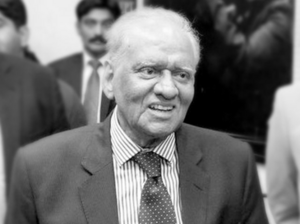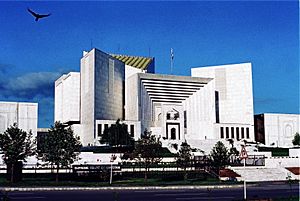Saeeduzzaman Siddiqui facts for kids
Quick facts for kids
Saeeduzzaman Siddiqui
|
|
|---|---|
| سعید الزمان صدیقی | |
 |
|
| 28th Governor of Sindh | |
| In office 11 November 2016 – 11 January 2017 |
|
| President | Mamnoon Hussain |
| Prime Minister | Nawaz Sharif |
| Preceded by | Ishratul Ibad Agha Siraj Durrani (Acting) |
| Succeeded by | Muhammad Zubair Umar |
| 15th Chief Justice of Pakistan | |
| In office 1 July 1999 – 26 January 2000 |
|
| Appointed by | Muhammad Rafiq Tarar |
| Preceded by | Ajmal Mian |
| Succeeded by | Irshad Hasan Khan |
| 7th Chief Justice Sindh High Court | |
| In office 5 November 1990 – 21 May 1992 |
|
| Preceded by | Sajjad Ali Shah |
| Succeeded by | Nasir Aslam Zahid |
| Personal details | |
| Born | 1 December 1939 Lucknow, United Provinces, British India (now in Uttar Pradesh, India) |
| Died | 11 January 2017 (aged 77) Karachi, Sindh, Pakistan |
| Spouse | Ashraf Saeeduzaman Siddique |
| Children | Afnan Saeeduzzaman Siddiqui |
| Parent | Muhammad Naeem Siddique Basheer-un-nisa |
| Alma mater | University of Dhaka University of Karachi |
Saeed Uz Zaman Siddiqui (born December 1, 1939 – died January 11, 2017) was an important Pakistani judge. He served as the 15th Chief Justice of Pakistan, which is the highest judge in the country. Before that, he was the 7th Chief Justice of the Sindh High Court. When he passed away, he was the 28th Governor of Sindh, a leader of the Sindh province.
Contents
Early Life and Education
Saeeduzzaman Siddiqui was born in Lucknow, which is now in India. He came from a family that valued education. He went to school in Lucknow and also in Kolkata.
He finished his high school (Matriculation) in 1952 in Dhaka, which was then part of East Pakistan (now Bangladesh). In 1954, he studied engineering sciences at the University of Dhaka. He even taught physics in the university's lab for a while.
Later, Siddiqui moved to Karachi, in West Pakistan. He joined University of Karachi in 1954. There, he earned a Bachelor of Arts degree in Philosophy and a law degree (L.L.B) in 1958. In 1960, he began working as a lawyer at the Sindh High Court.
Standing Up for Justice
Justice Siddiqui was recognized internationally for his strong beliefs. In 2000, he was offered honorary membership by judicial groups in Australia and Canada. This happened after he refused to take a new oath under the Provisional Constitutional Order (PCO).
The PCO was a special rule made by the military leader Pervez Musharraf. It was seen as a way to control the judges and the legal system. Justice Siddiqui believed taking this oath would go against his promise to protect Pakistan's original Constitution.
His brave decision was praised by judges in the United Kingdom. His stand for an independent judiciary later inspired the lawyers movement in Pakistan. This movement helped bring back Chief Justice Iftikhar Muhammad Chaudhry to his position.
Career Highlights
Justice Saeeduzzaman had a long and distinguished career in law.
Starting as a Lawyer
He officially became a lawyer in February 1961. By November 1963, he was allowed to practice in the High Court of West Pakistan. In November 1969, he became an advocate for the Supreme Court of Pakistan.
He was also involved in legal associations. He was elected as the Joint Secretary of the Karachi High Court Bar Association in 1967. He later served as the Honorary Secretary of the High Court Bar Library until 1980.
Becoming a Judge
On May 5, 1980, he was appointed as a judge of the Sindh High Court. He then became the Chief Justice of the Sindh High Court on November 5, 1990. On May 23, 1992, he was appointed as a judge of the Supreme Court of Pakistan.
Chief Justice of Pakistan
Justice Siddiqui became the 15th Chief Justice of Pakistan on July 1, 1999. He was the Chief Justice when the military took over the government in 1999. This event was led by General Pervez Musharraf.
General Musharraf asked Justice Siddiqui to take a new oath under the Provisional Constitutional Order (PCO). But Justice Siddiqui bravely refused. He said, "Taking an oath under the PCO, in my opinion, will be a deviation from the oath I had taken to defend the constitution of 1973." The PCO would have weakened the independence of the judges and allowed the military rule to continue.
After Retirement from the Supreme Court
Because he refused to take the PCO oath, he was forced to leave his position by the military government. His time as Chief Justice was cut short. After a long discussion with several army generals, he still refused the oath. As a result, he and his family were placed under house arrest.
In 2008, he was nominated by political parties like Pakistan Muslim League (N) to become the President of Pakistan. He ran against Asif Ali Zardari but did not win the election. He was considered a fair and neutral candidate. He was again considered for the presidency in 2013, but another candidate was chosen at the last minute.
Governor of Sindh
On November 9, 2016, Justice Siddiqui was asked by Nawaz Sharif to become the Governor of Sindh. He took the oath as the 31st Governor of Sindh on November 11, 2016. He served in this important role until his death two months later.
Illness and Passing
In November 2016, Justice Siddiqui became ill with pneumonia and was taken to the hospital. He returned to the Governor House in December 2016. Sadly, he got pneumonia again in his other lung and passed away on January 11, 2017, while still serving as Governor. He was 77 years old.
His funeral was held at the Governor House. He was only the second person in Pakistan's history, after the country's founder Muhammad Ali Jinnah, to receive a state funeral.
In 2018, Justice Siddiqui was given the Sitara-i-Imtiaz award after his death. This is Pakistan's third highest award for civilians, recognizing his great service to the country.
Images for kids
See also
- Supreme Court of Pakistan
- Chief Justices of Pakistan
- Nawaz Sharif
- Pakistan Muslim League (N)
- Provisional Constitutional Order
- List of Pakistanis



